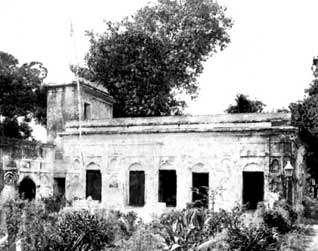Architecture
Historical Gurdwaras of Bangladesh
WAQAR A. KHAN
I spent a part of my impressionable years, that is to say, my boyhood school days in Islamabad, West Punjab, Pakistan. During my stay there, I made memorable visits mostly to the northern regions of Pakistan. I also visited the cosmopolitan cities of Karachi and Lahore. I was particularly enamored of Lahore, once a fabled city of the grand Mughals, Sikhs and later on of the British Raj where Sikhs, Hindus, Muslims and other communities once coexisted amidst great harmony and amity.
Lahore in the British colonial days had rightly earned the enviable sobriquet as, “Paris of the Orient” (see the engrossing book, ‘Lahore: A Sentimental Journey’, by Pran Necile, 1993).
Even in the late 1960s, it exuded a charm of its own with its Mughal monuments and gardens – the Lahore fort, Shalimar and Shahdara Baghs, Badshahi and Wazir Khan's mosques, mausoleums of Jahangir and Nur Jahan, Anarkali bazaar and the tree lined Mall, to name a few.
However, besides the “Ajaib Ghar” (Lahore Museum) and “ Kim's Gun” (Ranjit Singh’s Zamzama) made famous by Rudyard Kipling, the old Lahore Fort along with its Sikh era exhibits which included the priceless collection that once belonged to daughter of the last Emperor of Punjab, Maharaja Duleep Singh - Princess Bamba Duleep Singh Sutherland - attracted me the most.
On my very first visit to the Lahore Fort, I was drawn to remnants of some interesting, fading Sikh murals on a wall in an inner courtyard. It looked somewhat incongruous in its setting and thus attracted my attention. However, the guide could not say much beyond reluctantly conceding with a grimace that, ”woh Sikho(n) ka hai” (those are of the Sikhs).
He was neither interested nor knowledgeable in Sikh history. Such a peculiar mindset - one of disdain and denial - was understandable given that in wake of the Partition of Punjab and the subcontinent in 1947, the horrors that befell the Punjab were still fresh.
Furthermore, the guide was too eager to point out the Mughal features of the fort in which he was also ill informed. Leaving the fort, I went to see the adjacent, elegant Samadhi (memorial) of the great Sikh Emperor, Maharaja Ranjit Singh (1780-1839) , the “Lion of the Punjab“. My abiding interest in the magnificent, yet short lived Sikh kingdom (1799-1849), and the history of the brave, hardy and industrious Sikhs of the Punjab had begun.
Ranjit Singh was a born ruler. He united the various Sikh misls (confederations) and built a powerful empire in the Punjab, with Lahore as his capital. At its zenith the whole of Punjab, Peshawar up to Khyber Pass, Kashmir, western Tibet (Ladakh) and Sindh was under his sway.
In the context of his time, Ranjit arguably possessed the most formidable modern army in South Asia, trained and commanded by some legendary foreign mercenaries – Neapolitan and French officers - some of whom had once served in Napoleon's army. However, the Sikh court politics and culture, fueled by British mischief and Hindu Dogra treason, remained in a modern era, essentially medieval in character, with its penchant for intrigue, assassination, and dissension and reckless adventurism, initiating the concocted wars by the East India Company.
As a result, the once powerful Sikh kingdom was eventually annexed by the Company in 1849, following the so-called Anglo-Sikh wars, only ten years after Ranjit's death in 1839.
Since long, I have been reading up on the history of the Sikhs. Consequently, I have developed a great admiration for a brave, colorful, vibrant, enterprising and gregarious people. Even from the rusticity of the villagers in East Punjab emanate an endearing warmth, gaiety and celebration of life, especially, through their songs and dances during various festivals. On the other hand, the somber, sonorous and lilting devotional kirtan sung in the Sikh gurdwaras are soulful, seemingly a constant reminder of their past sufferings as a people and their enduring quest for the unity of faith and appeal to the universal brotherhood of Man.
A word about the Sikh religion. Sikhism is a monotheistic religion which originated in the Punjab in the 15th century, as propounded by Guru Nanak, its founder and first Guru or spiritual teacher. He was succeeded by nine other Gurus. On the death of the Tenth Master, Guru Gobind Singh, the Sikh Scripture, Guru Granth Sahib, was declared as the eternal Guru, whereby, it became in effect the embodiment of the living spiritual guide of the Sikhs.
In Bangladesh there are approximately seven gurdwaras in Dhaka, Mymensingh, Chittagong and Sylhet alone. There are 30 million adherents to the Sikh faith worldwide.
In May 2016, Bangladesh Forum for Heritage Studies, an organization dedicated to the promotion of cultural heritage, handed over four rare photographs taken in 1950 of the Gurdwara Nanak Shahi at Nilkhet, Dhaka, to the Gurdwara Management Committee in a simple ceremony.
The four rare photographs of the Gurdwara of 1950, taken soon after the partition of Punjab and the subcontinent in 1947, documents the main gurdwara built in 1830, during the East India Company era. The adjacent auxiliary or support buildings, which then housed the Langar and Musafir-khana (rest-house for guests/pilgrims), were probably also built during the same time as the gurdwara, as evident from the same architectural pattern. The gurdwara and the adjacent buildings as seen in these pictures of 1950, appear to have been in a fairly pristine condition then.
The pictures show the main gurdwara, a Company era building, with its distinctive Punjabi-Mughal architectural features (especially the interior). In one of the photos it is interesting to note the presence of Sikh samadhis (memorials) on the compound at the rear end of the gurdwara. Also, in the pictures can be seen a few male Sikhs.
One such photo probably shows the then lone granthi, the brave and dedicated, Bhai Swaran Singh, sitting on an ornate wicker chair with his long, loose hair after a bath. Bhai Swaran Singh stayed back after the Partition of 1947, to look after the gurdwara, when all else had left for the newly created country of India. Sadly, he along with his Bengali Muslim friend were brutally killed during the 1971 Bangladesh war.
Known today as the Gurdwara Nanak Shahi located in Nilkhet, on the Dhaka University Campus, the original Gurdwara was erected on this spot much earlier as it was deemed a sacred place by the Sikhs. Legend has it that Guru Nanak (1469-1539) on his visit to Dhaka, had stayed at this place to talk about his universal message. And, so did the Sixth Master, Guru Teg Bahadar (1621-1675) after him, who also lived in Dhaka for two years.
The place was then a Mughal mohallah (locality) and fell under the Sujatpur mouza . A humble gurdwara was first constructed here by a Sikh devotee, Bhai Natha, during the time of the Sixth Guru. The Gurdwara in the photographs date from 1830, when the earlier old gurdwara buildings were rebuilt along with additional ancillary edifices. Thus, this gurdwara structure in Dhaka is considered by the Sikhs as one of the oldest on the subcontinent.
From 1947 until 1964, the gurdwara somehow managed to stay functional with financial help from local devotees and Sikh pilgrims from India. Monetary donations, however paltry, were also had from Sikh personnel working for UN agencies in Dhaka and diasporan Sikhs. However, such funds were insufficient for the overall physical upkeep of the gurdwara buildings and premises.
Consequently, the gurdwara complex soon started to show signs of neglect and suffered from lack of repair. But the real downturn in the fortune of the gurdwara started with the state sponsored communal riots in the then East Pakistan in 1964, followed by the Indo-Pakistan war of 1965, after which hostilities stopped all Sikh pilgrims from India. Therefore, regular funds were seriously affected. Within a very short time the gurdwara complex bore a dilapidated, forlorn and abandoned look. Invasive vegetation and adverse climatic conditions made things worse.
Through all this, Bhai Swaran Singh prevailed until killed in 1971.
On the liberation of Bangladesh, when the Sikhs of the Indian Army entered Dhaka on December 16, 1971, Sikh officers and soldiers prayed in thanksgiving in this ruined gurdwara. During 1972 some funds were made available, and rudimentary efforts at restoration and cleaning up were conducted.
In 1973 some locals started to demolish a ruined portion of the Gurdwara adjacent to the Arts faculty of Dhaka University. Thankfully, it was stopped before any major damage was done to the remnants of the Gurdwara.
Finally, through the noble initiative of Sardar Harbans Singh, the then Chairman, International Jute Organization in Dhaka, a major restoration project of the Gurdwara was undertaken in 1988 and completed in 1989.
Thus, the Gurdwara was made fully functional as a place of visitation and worship. Funds for this major restoration project were procured by the relentless efforts of S. Harbans Singh, from diasporan Sikh donations. However, while the exterior façade of the gurdwara has undergone major structural changes, care was taken to preserve the attractive original interior with some changes made in the layout, like the added parkarma verandah around the holy inner sanctum to provide overall protection to the Darbar Sahib where the Guru Granth Sahib (Scripture) is kept on a new, beautifully carved, high marble throne.
Waheguru Ji ka Khalsa, Sri Waheguru Ji ki Fateh! Sat Sri Akaal.
[The author is founder, Bangladesh Forum for Heritage Studies. The photographs are from his personal collection.]
[Courtesy: The Daily Star. Edited for sikhchic.com]
April 11, 2017




